Colloquia for Spring 2015
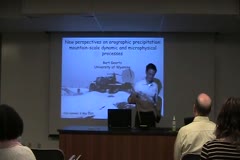
Fine-scale dynamical and microphysical processes of snowfall from shallow orographic clouds
May 08, 2015
Bart Geerts
Hosted by Russ Schumacher
Light snowfall often falls over mountains long after deep frontal disturbances have passed. We use high-resolution profiling radar observations over Colorado and Wyoming, as well as numerical simulations, to explore mechanisms of such persistent precipitation from rather shallow clouds. These clouds are often convective, in which case they tend to deposit relatively more snow on the lee side of…

Effects of Thunderstorms on Tropospheric Trace Gas Chemistry
April 30, 2015
Mary C. Barth
Hosted by Steven Rutledge
Thunderstorms are interesting from an atmospheric chemistry perspective because their convective outflow regions produce ozone in the upper troposphere, where ozone is radiatively active as a greenhouse gas. The ozone production comes about because the convective outflow contains an abundance of ozone precursors: hydrogen oxides (HOx) radicals and their precursors, as well as nitrogen oxides…
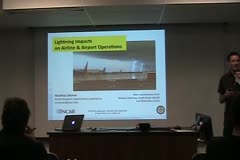
Lightning Impacts on Airline and Airport Operations
April 24, 2015
Matthias Steiner
Hosted by Russ Schumacher
Thunderstorms and lightning pose a safety risk to personnel working outdoors. Airport and airline operators, therefore, employ safety procedures that include observations and warnings of the onset and duration of lightning hazards. Ramp closures are needed to ensure the safety of outdoor personnel servicing gate-side aircraft. Yet halting outdoor work delays air traffic and can cause ripple…
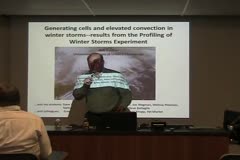
Generating cells and elevated convection in winter storms - results from the Profiling of Winter Storms Experiment
April 23, 2015
Robert M. Rauber
Hosted by Jeff Collett
In the 1950s, pioneering scientists used the new technology of vertically pointing radar to discover that the warm frontal and occluded sectors of winter cyclones were commonly topped by convective .generating cells. that produced snow streamers that merged and were organized by shear to produce linear bands. Although studies further explored these ideas in the subsequent decades, the concept…
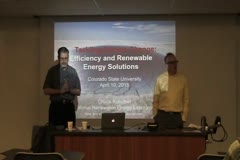
Tackling Climate Change via the Rapid Transition to Energy Efficiency and Renewable Energy Technologies
April 10, 2015
Chuck Kutscher
Hosted by Scott Denning
Climate change is increasingly being recognized as a growing environmental crisis that must be addressed. Studies have shown that the costs of addressing this problem are much less than the costs of dealing with the consequences. Because the major driver is the emission of greenhouse gases associated with the burning of fossil fuels, the most direct way to address the problem is to rapidly…
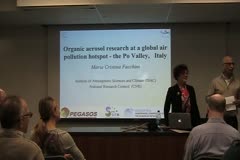
Aerosol research at a global air pollution hotspot - the Po Valley, Italy
April 03, 2015
Maria Cristina Facchini
Hosted by A.R. Ravishankara and Jeff Pierce
The Po Valley is a hot spot for air pollution both for the emission sources due to the intense industrial, agricultural and trading activities and the orography of the Valley, surrounded on three sides by high mountain ranges, that favors the accumulation of particulate and gaseous pollutants in the lower levels of the atmosphere. The Po Valley is an ideal natural laboratory to study the…
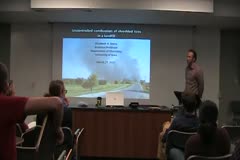
Uncontrolled combustion of shredded tires in a landfill
March 27, 2015
Elizabeth A. Stone
Hosted by Jeff Pierce
In summer 2012, a landfill liner comprising an estimated 1.3 million shredded tires burned in Iowa City, Iowa. During the fire, continuous monitoring and laboratory measurements were used to characterize the gaseous and particulate emissions. In the tire fire plume, we observed significant enrichments in ambient concentrations of CO, CO2, SO2, particle number (PN), fine…
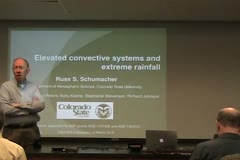
Elevated convective systems and extreme rainfall
March 13, 2015
Russ Schumacher
Hosted by Dick Johnson
In the central and eastern U.S., as well as other continental locations at midlatitudes around the world, warm-season heavy precipitation is most frequent at night. This suggests that the convection responsible for the heavy rainfall is not primarily originating at the surface, which stabilizes after dark, but from unstable air located somewhere above the surface: "elevated convection."…
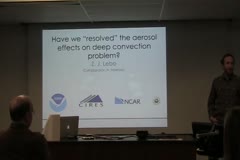
Have we "resolved" the aerosol effects on deep convection problem?
March 06, 2015
Zach Lebo
Hosted by Jeff Pierce and Sue van den Heever
A growing interest in the potential effects of aerosol perturbations on deep convective clouds has resulted in numerous publications over the past decade. These studies have primarily focused on aerosol-induced changes in updraft strength, precipitation amount, precipitation patterns, and lightning frequency. In this talk, I will highlight the primary mechanisms for aerosol effects on deep…
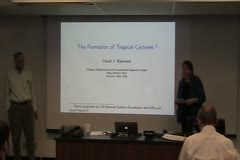
The Formation of Tropical Cyclones
February 27, 2015
David J. Raymond
Hosted by Sue van den Heever
In this talk I will review the history of thought regarding the formation of tropical cyclones. The conditions required for their formation as presented by William Gray, John McBride, and Raymond Zehr are first discussed, followed by a review of early work by Jule Charney and others. The results of observational programs in the east and west Pacific and theoretical studies in the 1990s are…
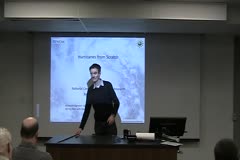
Hurricanes from Scratch
February 20, 2015
Christopher Davis
Hosted by Russ Schumacher
The upscale aggregation of convection is used to understand the emergence of rotating, coherent mid-tropospheric structures and the subsequent process of tropical cyclone formation. The CM1 model is integrated on an f-plane with uniform SST and prescribed uniform background flow. Moist cyclonic vortices form, merge, and eventually result in a single dominant vortex that subsequently forms a…
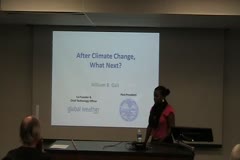
After Climate Change, What Next?
February 13, 2015
Bill Gail
Hosted by FORTCAST
Climate change represents an enormous challenge for today's generations. Yet we are thinking too small if we conclude its primary lessons concern greenhouse gases or even energy sustainability. The deeper lesson is about the critical milestone humanity has achieved with the scale of its reach. We can now readily change Earth in its entirety, something civilization has never been able to do…
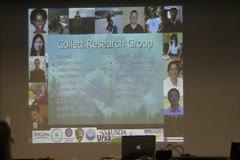
Faculty-Intro Jamboree
January 30, 2015
Profs. Collett, Denning, Kummerow, Ravishankara, Rutledge, Schubert, Thompson, van den Heever
Hosted by N/A
Provid overview of research areas and groups in the department.
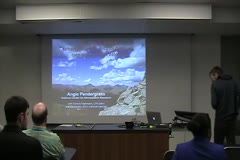
The rain is askew: changes in the distributions of rain and vertical velocity
January 23, 2015
Angie Pendergrass
Hosted by Dave Thompson
N/A
